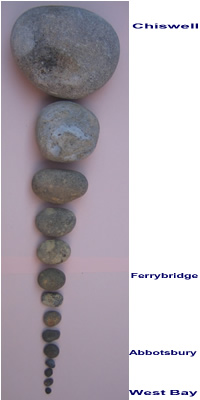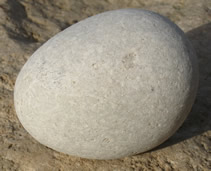Chesil Beach and the Fleet Lagoon
18 miles and 180 billion pebbles


Copyright Chesil Multi-
Last updated 1/11/24
Chesil Beach is made up almost entirely of pebbles of various rock types. The only exception is in the north-
The types of pebble that can be found are:
Flint
Flint originates from the chalk beds. They include the slightly brownish pebbles, most of the medium grey pebbles and also the less well-
Chert
The chert pebbles are also extremely hard and originate from the upper greensand beds. They are often fairly clear and translucent with a pink or bluish tinge.
Quartzite
Quartzite pebbles originate from around Buddleigh Salterton and are discoidal pebbles coloured red, purple "liver-
Granite
Granite is occasionally found on Chesil Beach. It can be identified by the coarse grain size, the pink or white feldspar, the quartz of glassy grey appearance, and the black mafic minerals, normally mica and/or hornblende. These pebbles probably originated from further west on the south-
Porphyry
These pebbles most probably come from the Permian breccia in Dawlish, Devon. They are similar to granite in appearance, but the crystal structure is rather different. They are comparatively rare on Chesil Beach.
Tourmalised rock
Pebbles of hard black, finely granular material are common. Somewhat irregular pebble of vein quartz, stained yellowish, and tourmalinised slate, all sheared and partially brecciated. The pebbles are usually irregular in shape as the tourmaline is quite brittle.


Breccia
A breccia is a rock of angular fragments. Only breccias that have been cemented strongly in hard silica can survive on Chesil Beach.
Portland stone
At Chiswell there are some limestone pebbles originating from the local Portland and Purbeck stone formations.
Kimmeridge oil shale
There is evidence that there was once an outcrop of oil shale on the back of Chesil Beach near Victoria Square on Portland. Pieces of shale can still be found on the beach and probably come from an outcrop under the sea off Chiswell.
Fossils
These are mostly found around Burton Bradstock and originate from the local cliffs.
Magnetite
This is believed to originate from the cargos of ships wrecked on Chesil Beach. The major concentration is near Abbotsbury and is believed to come from the SS Dorothea.
Peat
Pieces of peat can be found on Chesil Beach, particularly after storms. It comes from outcrops below the low tide level. It is mostly found at Chiswell and in an area around the tank defences at Abbotsbury
Pumice stone
Pieces of pumice stone are sometimes found washed up on the beach. Pumice is lava foam from volcanoes and contains sufficient air pockets to float. The stones on Chesil almost certainly came from volcanoes in the Caribbean Sea or central America. The colour varies from dark grey to almost white. They can be recognised by the large number of air pockets and that they are very light. It can be distinguished from building stone as the air pockets are irregular in shape and position.
Building stone
There is a type of building block that closely resembles pumice stone and this can be found on the beach. It is usually lighter in colour and softer than true pumice stone. There are also some brick fragments on the beach from demolished buildings.
Cinders
Lumps of cinder are common along the Fleet side of Chesil Beach. Most are thought to come from the days of steam ships when ships would discard cinders from the boilers. Some floated and came ashore on Chesil Beach. Being light they were transported over the beach top and came to rest on the Fleet side of the beach crest.
Crude oil conglomerates
A modern contribution to the beach is crude oil conglomerates. They originate from the late twentieth century when tankers would regularly flush their tanks while travelling down-
Others
Also found on Chesil Beach are Jasper, Agate, and Madrepores, but these are all very rare.


Limestone pebble from the beach at Chiswell
Further information
For a more detailed discussion of the pebbles that make up Chesil Beach and the underlying geology visit Ian West's excellent website at Southampton University.
Removal of pebbles
Pebbles have been removed from Chesil Beach for commercial purposes for much of the 20th century. A small amount were removed from near Chiswell, possible amounting to 10,000 tonnes. A much larger amount were removed from the area between Abbotsbury and West Bexington, possible as much as 1,100,000 tonnes.
This commercial extraction has now ceased. Today, even casual removal of pebbles by individuals is discouraged to ensure the long term survival of the beach
Pumice stone from Chesil Beach


A crude oil conglomerate containing numerous pieces of plastic
A piece of cinder from Chesil Beach
